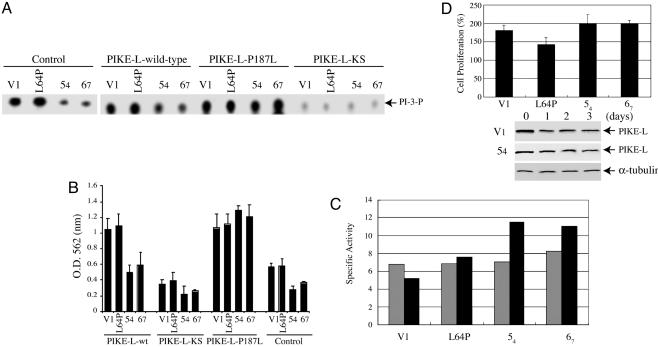Fig. 4.
merlin suppresses PI3-kinase activity through PIKE-L. (A) TLC was used to assay PI3-kinase activity in rat RT4-D6P2T schwannoma cells, which were infected with control adenovirus or adenovirus expressing WT PIKE-L, PIKE-L-KS, or PIKE-L-P187L. Infection with WT PIKE-L or PIKE-L-P187L resulted in an increase in PI3-kinase activity compared with control infected. This effect was suppressed in the merlin-expressing clones 54 and 67. PI3-kinase activity was unaffected in merlin clones infected with PIKE-L-P187L or merlin mutant L64P infected with either WT or P187L PIKE-L, presumably because of the inability of merlin or PIKE-L to cointeract. As expected, the dominant-negative mutant, PIKE-L-KS, inhibited PI3-kinase. (B) The number of proliferating rat RT4-D6P2T schwannoma cells was measured by MTT assay. Cellular proliferation paralleled PI3-kinase activity. (C) Caspase-3 activity assay. Empty vector (V1), merlin mutant L64P, and WT merlin (54 and 67) cells were induced for 3 days. Caspase-3 activity assay was conducted with 30 μg of protein from day 0 (gray bar) and 3 (black bar) samples. Induction of WT merlin substantially increases apoptosis compared with control or L64P mutant. (D) Knocking down PIKE-L abolishes the tumor-suppressive activity of merlin. The cells was induced and infected with adenovirus expressing sh-PIKE RNA. The expression of PIKE-L in both L64P and 54 cells was decreased substantially upon infection of PIKE RNA interference (blots). Surprisingly, knocking down PIKE-L robustly increases cell proliferation in 54 and 67 cells compared with control and L64P cells (graph). The results were expressed as means ± SEM calculated from five times of determination (P < 0.05).

